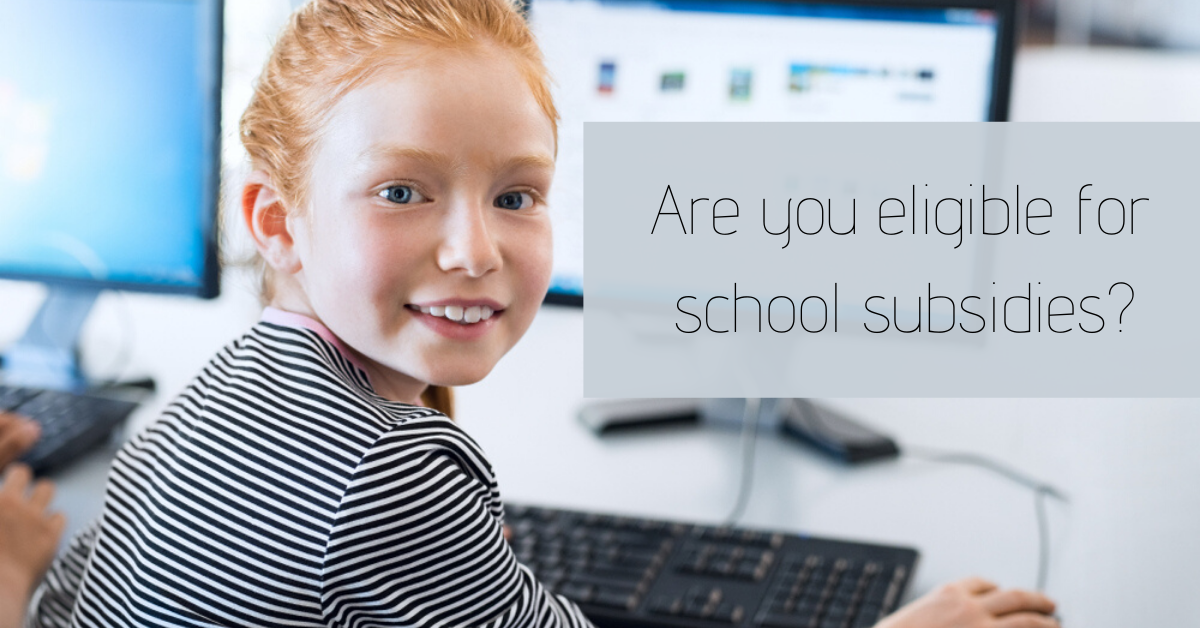Are you eligible for school subsidies?
With 2020 now in motion, many parents and carers are probably looking at how they’ll cover school fees for the year ahead, not to mention other costs, which might include things like uniforms, shoes, stationery, excursions and transport.
The good news is, you may be eligible for some financial assistance through subsidies in your state or territory, which may be means tested or require you to hold a concession card.
State and territory allowances
According to figures from Australian Scholarship Group (ASG), for a child born today, the total cost of schooling in a capital city (from ages 0 to 17) is estimated to be around:
$78,234 if they attend government schools
$148,019 if they attend systemic/catholic schools
$351,682 if they attend private schools.
With that in mind, it’s worth exploring some of the rebates and tax breaks you as a parent or guardian may be eligible for.
New South Wales
Children in Kindergarten through to Year 12, who are aged between four and a half and 18 (including those that are home-schooled), are eligible for an Active Kids Voucher, providing parents and guardians with $100 to put toward registration and participation costs for sport and fitness activities.
The Creative Kids program provides one $100 voucher each year to all school-aged children to help with the cost of creative classes and activities, such as music, dance and drama lessons, language classes, coding and design.
In addition, if you drive the kids to school because there’s no public transport where you live, you may be eligible for the School Drive Subsidy.
There are also two financial support programs for eligible families who have children boarding away from home to complete their secondary education.
Queensland
If you have secondary-school-age students who are attending state and approved non-state schools, you may be able to receive financial assistance to help with the cost of textbooks and other learning resources.
A Living Away from Home Allowance Scheme is also available, while talented students from regional and remote areas, who aren’t eligible, may apply for Queensland Academies Isolated Students Bursary.
On top of that, a voucher of up to $150 under the Fairplay voucher may also be available for children who can least afford or may otherwise benefit from joining a sport or recreation club, while there are additional funding sources that aim to support young athletes.
Victoria
Depending on your situation, your family may be eligible to receive free or discounted uniforms, shoes, textbooks, stationery and more through the State Schools’ Relief.
The Camps, Sports and Excursions Fund may also provide payments so eligible students can take part in school trips and various sporting activities.
South Australia
The School Card scheme assists with expenses, such as school fees, uniforms, camps and excursions. This is available for eligible students attending government schools.
The State Education Allowance is also available to geographically isolated parents with children at secondary level, who board away from home to attend school. The allowance assists with travel, boarding and other education-related expenses.
Western Australia
The Secondary Assistance Scheme is available to parents who hold eligible concession cards. It provides an education program allowance, which is paid to the school, and a clothing allowance that can be paid to the school or parent.
A Boarding Away from Home Allowance also assists geographically isolated families with boarding and education costs for primary and secondary-school-age children.
Tasmania
The Student Assistance Scheme assists with the cost of school levies. It provides support to low-income families to help with the cost of students in kindergarten through to year 12.
Northern Territory
The Back to School Payment Scheme provides financial assistance to parents and guardians of children enrolled in a Northern Territory school, or who are registered for home-schooling. The entitlement can be used towards things like uniforms, books and school camps.
There’s also a Sport Voucher Scheme that assists with sport, recreation and cultural-activity costs. And, you may be eligible for financial help if your child must live away from home or travel long distances to go to school.
Australian Capital Territory
The Secondary Bursary Scheme and Student Support Fund programs aid eligible low-income earners in the state with dependent full-time students in years seven to 10.
Commonwealth Government assistance
Commonwealth Government assistance may also be available for eligible young people through Youth Allowance and various Assistance for Isolated Children programs.
There’s also a Child Care Subsidy (which replaced the Child Care Benefit and Child Care Rebate in July 2018) which may help with the cost of childcare if you meet certain criteria.
Another initiative the Australian Department of Social Services is involved in is Saver Plus – a program that’s delivered in 60 communities across the country. It delivers up to $500 in matched savings for education costs and provides free financial education workshops and support.
Other considerations
The cost of kids doesn’t come cheap, so it’s worthwhile making the most of the subsidies available to you.
In the meantime, if you need further help, speak to your school about what financial support is available. It might also worth talking to other parents who have children at the same school or schools nearby.
Talk to the team at ADR Wealth for help fitting your children’s education costs into your budget.
Source: AMP





